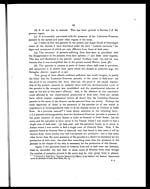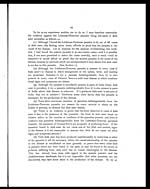Medicine - Institutions > Army health reports and medical documents > Scientific memoirs by officers of the Medical and Sanitary Departments of the Government of India > Number 19 - On kala azar, malaria and malarial cachexia > On kala azar, malaria and malarial cachexia
(52) Page 44
Download files
Individual page:
Thumbnail gallery: Grid view | List view

44
Some months ago I saw a European on whose body and limbs there were no
fewer than 35 Frontier Sores. In films made from five of the sores (all that
were examined) the parasites were found, and it is reasonable to suppose that
they were present in all, and that the total number of parasites present in the
tissues of this patient was enormous. Yet the patient, although many of the
sores had been present for six months, had not suffered from fever, his spleen
was not enlarged, and the only constitutional symptoms complained of were
attributable to the anxiety and worry caused by the presence of the sores.
I advised him to take two months' leave and gave him careful instructions
regarding the treatment of the sores by local applications. At the end of the two
months he wrote to inform me that all the sores were healed, and that he was
feeling perfectly well. Now, kala azar is a disease characterised by almost
constant fever and very severe constitutional symptoms; but a parasite indistin-
guishable from that which is said to be the cause of this disease does not produce
fever when present in cases of Oriental Sore: is there any reason to suppose
that a protozoal parasite which is incapable of producing fever when present
in the skin is capable of doing so when present in the spleen ?
The simplest way of getting over these difficulties is to say that the parasites
found in Delhi Sores and those found in kala azar, although indistinguishable in
appearance, are, in reality, distinct, because their geographical distribution is not
the same, and because they produce entirely different pathological effects; but
are these reasons sufficient ?
Finally, in addition to the difficulties arising out of a study of the parasites
of Oriental Sore, there is a point of some importance in connection with kala
azar and the parasites found in it that is not easy to understand. It is that the
fever met with in cases of kala azar bears no relation whatever either to the
number of parasites present in the spleen or to their condition. I was particularly
struck with this in the patients Hudoo (case 2), Elizabeth (case 1), Mangu
(case 9) and others. In the splenic blood of Hudoo the parasites were present
in enormous numbers, and I marked out the case for special study on account of
the large number of dividing forms of the parasite present. Yet the temperature
carefully taken thrice daily for 33 days only rose above normal on five occasions :
on three occasions it rose to 99°, on one to 101.4º, and on the fifth to 99.8°.
Similar facts were observed in the cases of Elizabeth and Mangu. On the
other hand, I have records of cases in which the temperature, remained continu-
ously high for a long period, yet in which extremely few parasites were present
in the spleen. These facts raise the suspicion that the fever met with at
some time or other in all cases of kala azar is not due to the presence of the
parasite under discussion; and if it does not cause the fever, may we not
reasonably doubt that it causes any of the other signs and symptoms ?
Set display mode to: Large image | Zoom image | Transcription
Images and transcriptions on this page, including medium image downloads, may be used under the Creative Commons Attribution 4.0 International Licence unless otherwise stated. ![]()
| Permanent URL | https://digital.nls.uk/75027629 |
|---|
| Shelfmark | IP/QB.10 |
|---|---|
| Additional NLS resources: | |




